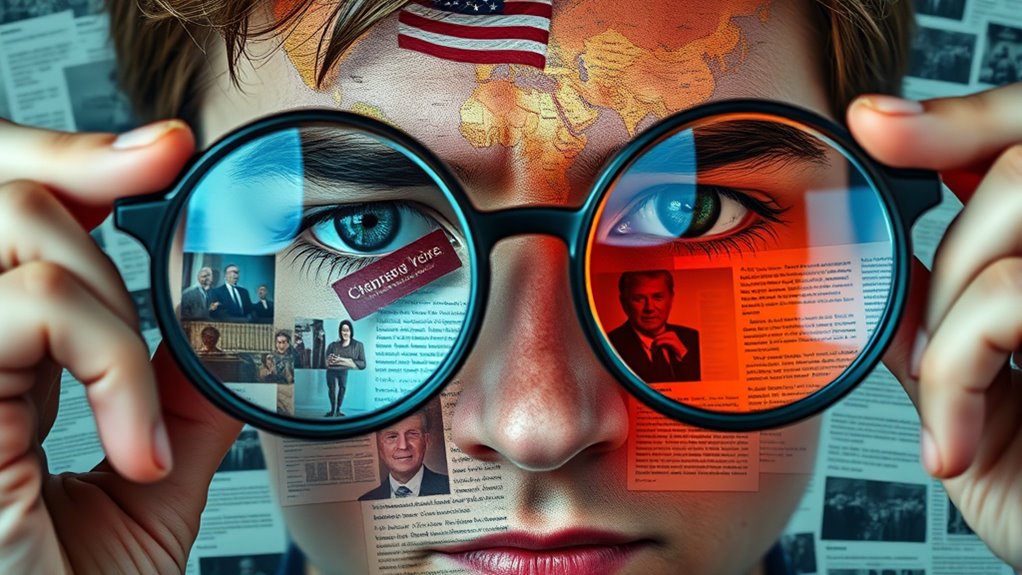Confirmation bias causes you to see what aligns with your existing beliefs, often leading you to interpret information selectively. You tend to notice details that support your views while ignoring or dismissing contradictory evidence. Emotions can intensify this effect, making your perceptions even more biased. Recognizing these patterns helps you avoid skewed judgments. If you want to understand how to spot and reduce this bias, there’s more to uncover below.
Key Takeaways
- Confirmation bias causes individuals to interpret information in a way that confirms their existing beliefs.
- It leads to noticing details that support opinions, while ignoring contradicting evidence.
- Emotions can reinforce bias, making people more likely to accept supporting info and dismiss opposition.
- Recognizing confirmation bias requires self-awareness and questioning assumptions regularly.
- Strategies like seeking diverse viewpoints help reduce bias and see situations more objectively.
How Confirmation Bias Shapes Our Perceptions

Confirmation bias influences how you interpret information by leading you to favor evidence that supports your existing beliefs. When you encounter new data, you tend to notice details that reinforce what you already think. Conversely, you ignore or dismiss evidence that challenges your views. This mental shortcut shapes your perceptions by filtering information through a biased lens. As a result, your understanding of situations becomes skewed, making it harder to see alternative perspectives clearly. You may even remember facts in a way that supports your beliefs, further cementing your worldview. This process occurs unconsciously, so you’re often unaware of how much your perceptions are influenced. For example, antioxidants found in honey can be seen as supporting health benefits, which may reinforce preexisting beliefs about their effectiveness. Moreover, selective perception can cause you to overlook evidence that contradicts your opinions, further entrenching your biases. Additionally, individuals often seek out media sources that align with their opinions, further reinforcing confirmation bias and limiting exposure to diverse viewpoints. Over time, confirmation bias solidifies your beliefs, making it difficult to accept new or contradictory information objectively.
The Role of Emotions in Confirming Beliefs

Emotions play a powerful role in reinforcing your beliefs because they can cloud your judgment and influence how you interpret information. When you feel strongly about a topic, your emotions can make you cling to evidence that supports your view while dismissing opposing facts. For example, if you’re angry or excited about an issue, you might interpret ambiguous information as confirmation of your stance. These feelings create a bias that feeds your desire for consistency, making it harder to see alternative perspectives objectively. Emotions act as a filter, amplifying your existing beliefs and making you more resistant to change. Recognizing this influence helps you understand why emotions can distort your perception and why it’s essential to approach information with awareness of your emotional state. Additionally, understanding the horsepower of electric dirt bikes can help you better evaluate energy and performance claims, reducing the likelihood of emotional bias affecting your judgments. Being aware of protective styling benefits can also help you evaluate styling choices more objectively rather than emotionally. Developing an understanding of color accuracy in projectors can further support more balanced and fact-based evaluations of visual information. Moreover, understanding how cognitive biases influence decision-making can further enhance your ability to see beyond emotional filters and consider alternative viewpoints more clearly.
Recognizing Confirmation Bias in Daily Life

Since confirmation bias often operates subtly, it can be difficult to recognize in everyday situations. You might notice it when you selectively seek out information that supports your opinions, ignoring evidence that contradicts them. For example, if you believe a particular health supplement works, you may focus only on success stories while dismissing studies showing no benefit. Pay attention to your reactions during discussions—do you dismiss opposing views too quickly? When reading news or social media, watch for patterns where you favor content aligning with your beliefs. Recognizing these tendencies requires self-awareness and honesty. Being mindful of your thought patterns helps you notice when confirmation bias influences your judgments, making it easier to challenge your assumptions and approach information more objectively. Additionally, understanding how cognitive biases like selective perception can distort your view of reality is essential for developing a more balanced perspective. Developing critical thinking skills can further help you identify and counteract confirmation bias in various situations. Recognizing the impact of cognitive distortions can also improve your ability to evaluate information more fairly.
Strategies to Minimize Your Biases

To effectively reduce your biases, start by actively seeking out information that challenges your existing beliefs. This helps you see beyond your default perspective and broadens your understanding. One effective strategy is to contemplate alternative viewpoints before forming conclusions. Additionally, question your assumptions regularly and look for evidence that contradicts your initial beliefs. To illustrate, here’s a quick guide:
| Be Open to | Question Your | Seek Contradictions |
|---|---|---|
| New ideas | Assumptions | Evidence |
| Different perspectives | Your beliefs | Opposing data |
| Challenging info | Biases | Alternative opinions |
The Impact of Confirmation Bias on Decision-Making

Confirmation bias considerably influences your decision-making by causing you to favor information that supports your existing beliefs while dismissing or ignoring evidence to the contrary. This bias can lead you to make skewed judgments, as you focus only on data that confirms what you already think. As a result, you might overlook important facts or alternative perspectives, which can lead to poor choices. In critical situations, this tendency limits your ability to see the full picture, increasing the risk of errors. By reinforcing your current beliefs, confirmation bias can cause you to stick with ineffective solutions or misjudge risks. Recognizing its impact helps you become more aware of your decision processes, encouraging you to seek diverse viewpoints and challenge your assumptions before acting. Understanding the mechanisms of cognitive biases can further help you develop strategies to mitigate their influence on your decisions, especially when evaluating information sources or making choices that impact your well-being. Additionally, being mindful of emotional influences can help prevent personal feelings from skewing your judgment. Being aware of how selective perception shapes your view can also improve your objectivity and decision accuracy.
Frequently Asked Questions
Can Confirmation Bias Affect Scientific Research and Findings?
You might wonder if confirmation bias influences scientific research. It definitely can, as it leads you to favor data that supports your beliefs while neglecting evidence to the contrary. This bias can cause you to interpret results subjectively, skewing findings and compromising objectivity. Recognizing this tendency helps you implement rigorous methods and peer review, ensuring your research remains unbiased and trustworthy, ultimately advancing scientific understanding.
How Does Confirmation Bias Influence Social Media Interactions?
You scroll, you Like, you share, and you comment, shaping your social media world. Confirmation bias influences your interactions by making you seek out content that aligns with your beliefs, dismissing opposing views. It filters your experience, reinforcing your opinions, and creating echo chambers. You see what you want to see, hear what confirms your thoughts, and ignore what challenges them, making your online environment more personalized but less open-minded.
Are Children More Susceptible to Confirmation Bias Than Adults?
You might wonder if children are more prone to confirmation bias than adults. Children tend to be more impressionable, so they often accept information that aligns with their existing beliefs without questioning it. Their developing critical thinking skills make them more vulnerable to sticking with familiar ideas. As you grow older, you learn to evaluate information more critically, reducing the likelihood of falling into confirmation bias.
Does Confirmation Bias Contribute to Political Polarization?
Imagine your mind as a camera, focusing sharply on familiar shapes while blurring the rest. That’s what confirmation bias does in politics. It causes you to highlight information that supports your beliefs and ignore the evidence that challenges them. This selective viewing deepens divides, making it harder to find common ground. By only seeing what confirms your views, you contribute to the growing polarization and lose sight of a balanced perspective.
Can Awareness of Confirmation Bias Eliminate Its Effects Entirely?
You wonder if recognizing confirmation bias can completely eliminate its influence. While awareness helps you identify when you’re favoring information that confirms your beliefs, it doesn’t erase the bias itself. Human psychology naturally gravitates toward confirming existing views, so awareness can reduce but not entirely eliminate its effects. To truly minimize bias, you need ongoing effort, critical thinking, and openness to conflicting evidence.
Conclusion
So, next time you’re convinced you’re right, remember that your mind might just be playing tricks on you. Confirmation bias makes you see what you want, not what’s true. Ironically, the more certain you are, the less likely you are to question yourself. So, enjoy your little bubble—just don’t be surprised if it keeps you from seeing the bigger picture. Sometimes, the truth is hiding just beyond your own biased vision.










